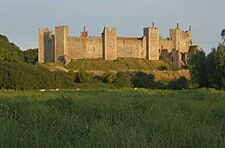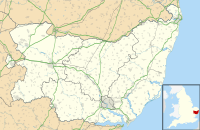Framlingham Castle facts for kids
Quick facts for kids Framlingham Castle |
|
|---|---|
| Framlingham, Suffolk, England | |

The Inner Court and Lower Court from the northwest
|
|
| Coordinates | 52°13′27″N 1°20′49″E / 52.22405°N 1.34691°E |
| Grid reference | grid reference TM 286 636 |
| Site information | |
| Owner | English Heritage |
| Open to the public |
Yes |
| Condition | Largely intact |
| Site history | |
| Materials | Flint, septaria and sandstone |
| Events | Revolt of 1173–1174, First Barons' War, Second World War |
Framlingham Castle is a historic castle in the town of Framlingham, Suffolk, England. The first castle on this site was built by the Normans around 900 years ago. That castle was destroyed by King Henry II after a rebellion.
A new, stronger castle was built in its place by a powerful noble named Roger Bigod. This new castle was special because it didn't have a central tower, or keep, like most castles. Instead, it was defended by a massive curtain wall with 13 towers built into it.
Over the centuries, the castle was home to powerful families like the Mowbrays and the Howards. It was turned into a luxurious home with beautiful gardens and large man-made lakes called meres. At one point, Mary I gathered her army here before marching to London to be crowned queen.
Later, the castle fell into ruin. In 1636, it was given to Pembroke College, Cambridge. The college turned the inside of the castle into a workhouse, a place where poor people lived and worked. During World War II, it was used by the British Army. Today, Framlingham Castle is cared for by English Heritage and is a popular place for tourists to visit.
Contents
History of the Castle
The First Castle
After the Norman Conquest of England in 1066, the town of Framlingham grew quickly. The land was owned by the powerful Bigod family. They built the first castle here, which was probably a simple wooden fort on a mound of earth, known as a motte and bailey castle.
The Bigod family often argued with the king. In 1157, King Henry II took away the family's four castles. He later returned Framlingham, but Hugh Bigod joined a rebellion against the king in 1173. The rebellion failed, and as a punishment, Henry II ordered Framlingham Castle to be destroyed in 1174.
A New Castle is Built
Hugh's son, Roger, got back into the king's good graces when Richard I became king in 1189. Roger then built the stone castle that we see today. It was finished by 1213 and was a very modern design for its time. It had a strong curtain wall with 13 towers instead of a single keep.
This new castle soon faced a test. During the First Barons' War, Roger Bigod joined a group of barons who were against King John. In 1216, King John arrived with his army to attack the castle. Roger, not wanting a long fight, quickly surrendered. The king's soldiers took control of the castle without a single battle.
A Luxurious Home
By the late 1200s, the castle had become a comfortable and luxurious home. A huge park, called the Great Park, was created around the castle for hunting deer. The Bigod family lived in grand style, but they also fell into debt. In 1306, the castle was given to the king.
King Edward II gave the castle to his half-brother, Thomas of Brotherton. For the next 200 years, it was owned by the powerful Mowbray and Howard families. They used Framlingham as their main home and spent a lot of money on it.
The castle household was very large, with over 80 people living there. They bought food and supplies from all over England and even luxury goods from other countries. Two large lakes, or meres, were created next to the castle. These were used for fishing and boating and made the castle look even more impressive.
The Tudor Era and a Future Queen
In the late 1400s, the Howard family began to modernize the castle. They used fashionable brick to build new sections and added many decorative chimneys. They also created beautiful pleasure gardens with ponds and walkways for the family and their guests to enjoy.
In 1553, the castle played a famous role in English history. After King Edward VI died, there was a struggle for the throne. Edward's half-sister, Mary, came to Framlingham Castle. She gathered her supporters and her army here. From Framlingham, she marched to London and was proclaimed Queen of England.
After Mary became queen, the castle was used less and began to fall into disrepair. As laws against Catholics became stricter, it was even used as a prison for priests and others who refused to follow the new religion.
From Workhouse to Tourist Attraction
In 1635, the castle was sold to Sir Robert Hitcham. When he died, he left the castle to Pembroke College, Cambridge. His will stated that the college must tear down the buildings inside the castle and build a workhouse for the poor.
The old medieval halls and chapels were pulled down, and a building called the Red House was built for the poor to live and work in. This workhouse was used on and off until 1839. After that, the castle served as a military drill hall and a local courthouse.
In 1913, Pembroke College gave control of the castle to the government to protect it as a historic site. During World War II, it was used by the army as part of Britain's defences against a possible invasion.
Today, Framlingham Castle is managed by English Heritage. It is a popular attraction where visitors can walk along the ancient walls and learn about its long and exciting history.
Castle Design and Features
Framlingham Castle is made up of three main areas: the Inner Court, the Lower Court, and the Bailey.
The Walls and Towers
The most impressive part of the castle is the Inner Court. It is protected by a huge stone curtain wall that is 10.5 metres (34 ft) high and 2.3 metres (7.5 ft) thick. Instead of a central keep, the wall has 13 square towers built into it.
These towers are open at the back. This made them cheaper to build, but it also meant they would be hard to defend if an enemy got onto the wall-walk. Visitors today can walk along the top of the wall and get amazing views of the surrounding countryside.
Inside the Walls
Originally, many buildings stood inside the Inner Court, including a chapel, a Great Hall, and kitchens. Most of these were torn down in the 17th and 18th centuries to make way for the poorhouse, which still stands today.
You can still see many fancy brick chimneys from the Tudor period. Most of these were just for decoration to make the castle look grand. In the middle of the court is the castle well, which is 30 metres (98 ft) deep.
The Mere and Gardens
One of the castle's most beautiful features was its setting. The large lakes, or meres, reflected the castle's image, making it look dramatic and powerful. This was a popular way to design castles in the Middle Ages.
The owners also created pleasure gardens with ponds and terraces. From the castle's windows, they would have looked out over the gardens, the shimmering mere, and the Great Park beyond. This created a stunning landscape designed to impress any visitor.
See also
- Castles in Great Britain and Ireland
- List of castles in England
- Church of St Michael the Archangel, Framlingham
- The place where the BBC shot a sketch for CBBC programme, Horrible Histories










